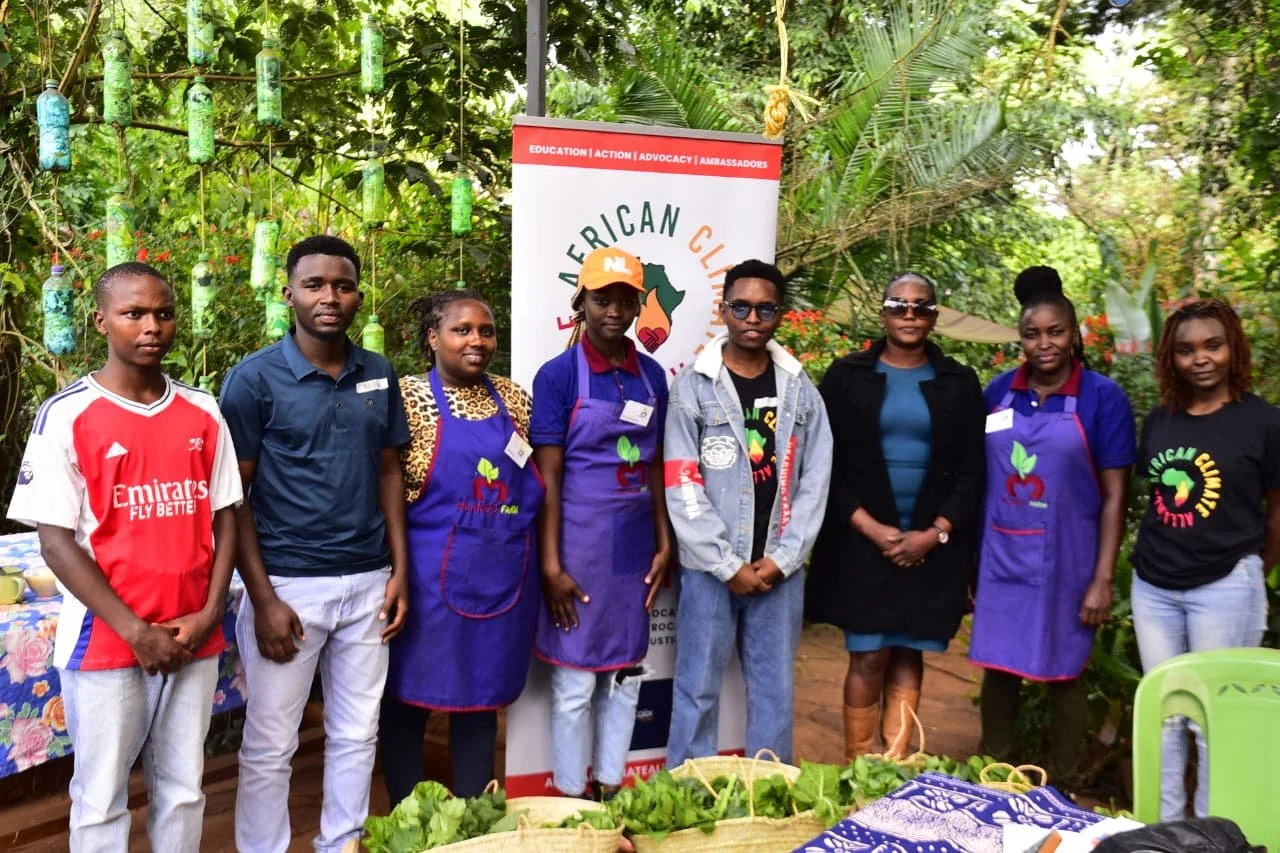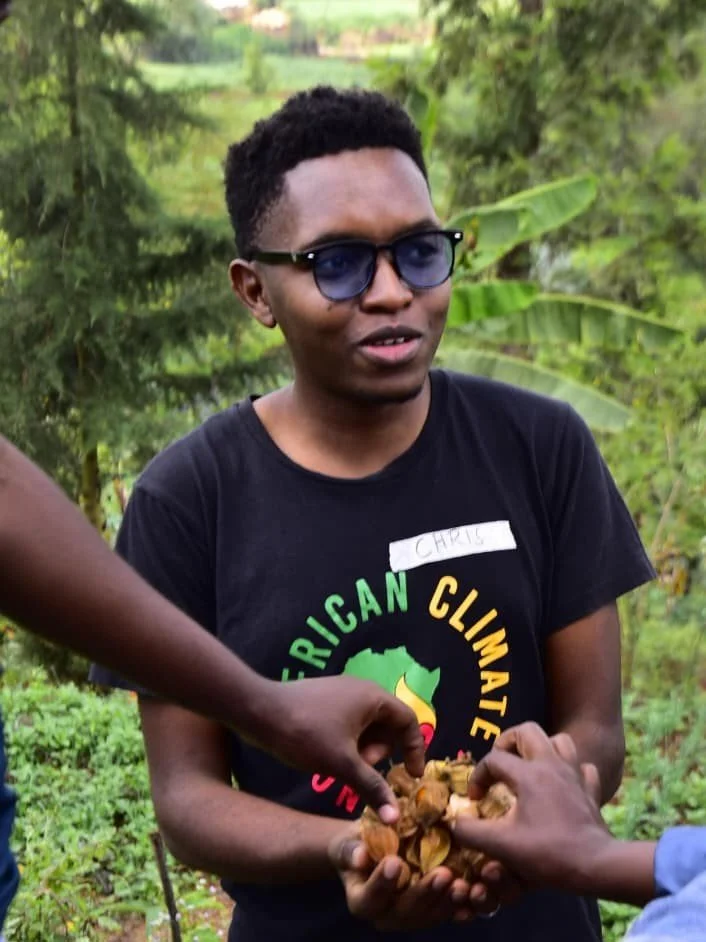Activist Spotlight: Christopher Mutuku on Why Indigenous Seed Is the Root of Climate Action
An interview with Christopher Mutuku, a Kenyan African Climate Alliance Ambassador who is helping young people reconnect with the land and indigenous seed as a climate solution.
Christopher Mutuku is a journalism student at the Kenya Institute of Mass Communication and the Founder of Calix Media, a youth-led production company dedicated to transforming powerful ideas into visual stories that inspire action.
Based in Makueni, Kenya, his activist journey began in 2021 when he started engaging in youth dialogues on environmental sustainability. What began as curiosity soon evolved into a deep passion for using media to amplify the voices of resilience and drive meaningful climate action. Christopher became an African Climate Alliance Ambassador in 2023 and has continued deepening his justice-centred work ever since.
In September, as part of our month of community-led climate action – featuring Cape Town Climate Week, Johannesburg Climate Week, and 8 community-based initiatives led by youth across the continent – Christopher hosted an event in Nairobi focused on why food justice is climate justice and why indigenous seed is a key solution.
We interviewed Christopher as part of our Activist Spotlight series to learn more about his journey and his African Climate Alliance Climate Week event.
Below are some of the highlights including:
Why the effects of climate change are deeply personal,
The need to bring youth and farmers together to tackle climate injustice,
And why indigenous seed is a climate solution that shouldn’t be overlooked.
What inspired you to join the African Climate Alliance?
I joined the African Climate Alliance (ACA) because I wanted to merge my passion for storytelling with activism. ACA created a platform for young Africans like me to use our creativity to raise awareness and push for change. Through ACA, I learned that storytelling can be a powerful advocacy tool — not just to inform, but to inspire.
What does climate justice mean to you personally and in your community’s context?
In my community, the effects of climate change are deeply personal. We’ve seen long dry spells that dry up rivers and boreholes, leaving families walking long distances just to fetch water. Unpredictable rains have made farming — our main source of livelihood — a constant gamble, leading to food shortages and rising costs that hit low-income households the hardest.
To me, climate justice means more than just addressing the environmental crisis. It’s about tackling the social injustices that make some communities more vulnerable than others. It’s about ensuring that people in rural and marginalised areas have equal access to clean water, nutritious food, and sustainable livelihoods. True climate justice, in my eyes, is when everyone — especially those most affected yet least responsible — is included in the solutions and empowered to shape a fairer, more resilient future.
Tell us about your Climate Week action — what was it, and what inspired the idea?
My Climate Week action focused on food justice and indigenous seed preservation. The event brought together youth, local farmers, and environmental enthusiasts for a film screening and discussion workshop, featuring an open-source documentary by Seed Savers Network Kenya, followed by a farm tour showcasing sustainable farming practices in action.
The goal was to spark meaningful conversations around food systems and inspire young people to reconnect with where their food comes from. The idea came from realising that while many young people are passionate about climate action, few have meaningful engagement with the agricultural systems that sustain our communities every day.
Your event focused on the Climate Week theme of food justice. Why is this so important to you?
Food justice matters to me because it connects directly to livelihoods, health, and culture. Access to safe and nutritious food shouldn’t depend on privilege or geography. In my community, I’ve watched farmers adapt with remarkable creativity — reviving traditional seed-saving methods, sharing water resources, and supporting one another through unpredictable seasons. Even as droughts dry up rivers and rains are delayed, their resilience tells a story of strength, not surrender.
For me, climate change is not just a statistic. It’s seeing families plant with faith that the rains will come, and youth stepping up to learn sustainable farming techniques. Addressing food justice means ensuring that this determination is met with real support — giving communities the resources, knowledge, and recognition they deserve to feed both people and hope.
The event was sponsored by the African Climate Alliance (ACA) and hosted at Mlango Farm, which served as the perfect venue partner. The farm offered an interactive environment where young people could literally connect with food from the farm to the table, making the theme of food justice come alive. As the content partner, Calix Media produced a mini-documentary capturing key discussions, youth perspectives, and highlights of the day. We were joined by local farmers, students, and community youth groups, making it a truly collaborative experience.
Why was it important for you to bring youth and farmers together?
It was important for me to bring youth and farmers together because both groups hold pieces of the solution. Farmers carry generations of indigenous knowledge — they understand the rhythm of the land in ways books can’t teach. Youth, on the other hand, bring fresh ideas, digital tools, and a drive to reimagine the future.
When these two worlds meet, something powerful happens. During our discussions, I watched young people listening closely as farmers shared how they predict weather changes by observing the wind or the soil. In return, the youth showed them how mobile apps and digital mapping can support those same instincts. That exchange of wisdom and creativity bridged generational gaps and reminded us all that agriculture isn’t a dying practice — it’s evolving, and it can be a form of climate action led by both tradition and technology.
How can indigenous seed be a climate solution?
Indigenous seeds are locally adapted, resilient, and capable of withstanding harsh climate conditions. Promoting their use helps preserve biodiversity and reduces dependency on commercial, climate-vulnerable seed varieties. During the event, we screened a Seed Savers Network Kenya documentary on indigenous seed preservation, which served as a learning tool for participants and deepened our understanding of the importance of protecting native seed systems.
Was there a moment during your action that stood out to you — something that made you feel proud, surprised, or hopeful?
There was a moment that really stood out during the action. A group of young participants is committed to starting small kitchen gardens at home after learning how climate change affects the food they eat. Seeing their excitement and determination in real-time made me proud — it showed that even small actions can spark hope and build resilience, and that awareness truly can lead to meaningful change.
What was your biggest takeaway from the day?
My biggest takeaway was that learning doesn’t always happen in classrooms. Sometimes, the most powerful lessons happen in open fields — through conversations, hands-on experiences, and shared meals. It reinforced my belief that storytelling and collaboration can bridge gaps between knowledge and action.
Immediately, the event created awareness and fostered dialogue between young people and farmers. The Calix Media mini-documentary extended that impact by allowing more youth to engage with the lessons online. In the longer term, it sparked new partnerships and inspired participants to take similar actions in their localities — proving that one story can inspire many.
What message would you share with other young people who want to take climate action in their own communities?
Start small, but start now. Climate action isn’t just for scientists or activists — it’s for everyone. Use what you have — your art, your voice, your creativity — to make a difference. Climate justice is social justice, and the power of change lies in collective effort. Every contribution, no matter how small, moves us closer to a more sustainable and just future.
What was the African Climate Alliance's month of climate action?
This year in September, across 19 events and 6 countries, we connected the dots between climate change and our many social crises. We showed that the climate crisis is not just about changing weather patterns, but it’s a human rights crisis that amplifies existing inequalities. It touches our lives when it comes to how we access food, water, energy, housing, transport, and impacts gender inequity.
Simply put: for the first time, September was our month of climate action.
We hosted the fourth Annual Cape Town Climate Week, the first-ever Johannesburg Climate Week, and for the first time, eight of our African Climate Alliance Ambassadors — young climate leaders who have been through our year-long mentorship programme — hosted their own Climate Week actions in Zimbabwe, Kenya, Malawi, Zambia, Nigeria, and South Africa.
All of the events brought together activists, community leaders, students, and citizens to learn about the connections between climate change and social injustices and showcase community-led solutions proving that climate justice must include food, water, energy, spatial, and gender justice at its core.
Expanding what started as Cape Town Climate Week across the continent showed us that climate justice doesn’t belong in one place, but can be built everywhere by young people leading in their own communities.
Learn more about Cape Town Climate Week and Johannesburg Climate Week.




